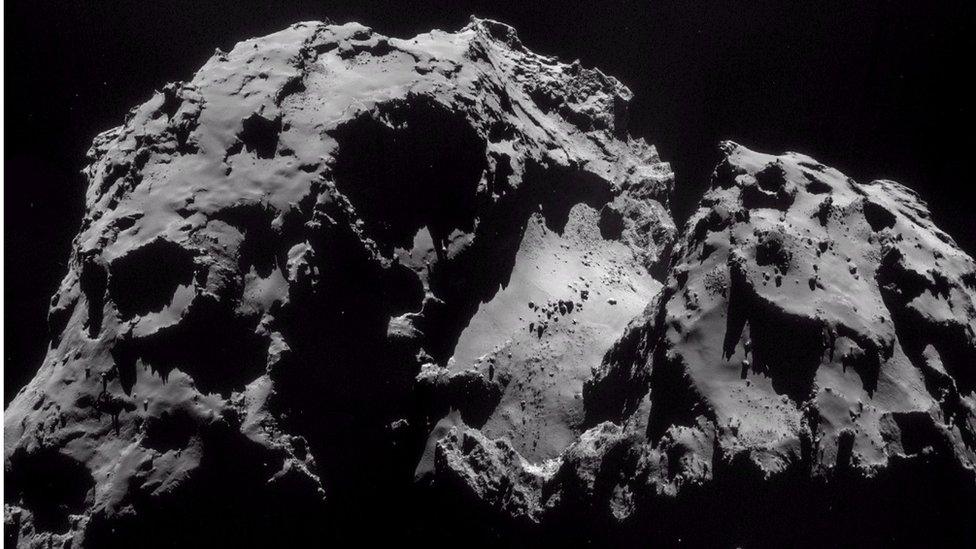Rosetta saw cliffs collapse on comet
- Published

A wide range of changes were observed on Comet 67P
The comet visited by the Rosetta spacecraft is constantly being re-shaped, sometimes in dramatic fashion.
It witnessed the collapse of entire cliffs at two locations on Comet 67P, events that were probably driven by exposure to sunlight.
The European probe, external documented the widespread breakdown of materials on the surface during nearly two years orbiting the 4km-wide body.
Details were presented at the Lunar and Planetary Science Conference (LPSC), external.

A huge boulder was seen to shift its position
Rosetta entered orbit around Comet 67P/Churyumov-Gerasimenko, to give its full name, in September 2014.
The mission enabled researchers to capture multiple images of the comet's surface features over time, to study how it changed.
"This is the first mission where we've been able to have such a huge dataset of high-resolution images, but at the same time had a long mission to a comet to study it and see how it evolves through more than two years as it journeyed through the inner Solar System," said lead author Mohamed El-Maarry, from the University of Colorado, Boulder.
Repeated heating and cooling can tease the surface materials apart, leading to erosion, say the researchers.
Dr El-Maarry and colleagues observed cliff collapses at two regions on the comet called Ash and Seth. These collapses occurred as pre-existing fractures gave way, causing sections of material tens of metres long to crumble.
In 67P's Khonsu region, a massive boulder was seen to move a distance of 140m. This could have been caused by erosion of the sloped surface the boulder was sitting on, causing it to roll. But the hefty rock could also have been moved by an outburst of dust and gas from within the comet, says the team.

End of mission: Rosetta was deactivated as the comet headed out towards Jupiter
At another location in the Anubis region, a steep slope retreated at a rate of 5.4m each day.
The authors note that most changes - including the erosion and the movement of boulders - occurred around perihelion, when Comet 67P was at the point in its orbital path closest to the Sun.
This suggests the events were driven by shifting patterns of exposure to sunlight.

Ash collapse: Yellow arrows mark the fractures where the detachment occurred
However, some of the changes were unrelated to this. In the "neck" region, which connects the two large lobes of the duck-shaped comet, a huge fracture, estimated to be more than 500m in length, extended by at least another 30m. This change is thought to be connected to an increase in the comet's spinning rate.
"We see a lot of changes, but most of those are localised," said Dr El-Maarry. "We didn't get fireworks and comets splitting and massive depressions being created. We didn't see major changes in the comet's landscape. It means we had more activity earlier in the comet's lifetime."
Comet 67P was discovered in 1969 by the Soviet astronomers Klim Churyumov and Svetlana Gerasimenko, after whom it is named.
Rosetta was dumped on the surface of the icy dirt-ball in September last year and deactivated.
The LPSC runs from 20-24 March in the Woodlands, Texas. As well as reporting the 67P observations at the meeting, Mohamed El-Marry and colleagues have written up a report for the journal Science, external.
A companion paper on surface changes was timed for simultaneous release in the journal Nature Astronomy, external. Authored by Maurizio Pajola and colleagues, this study concentrated on the circumstances surrounding the collapse of a cliff called Aswan.

Crack propagation was thought to be linked to the comet's increasing spin rate